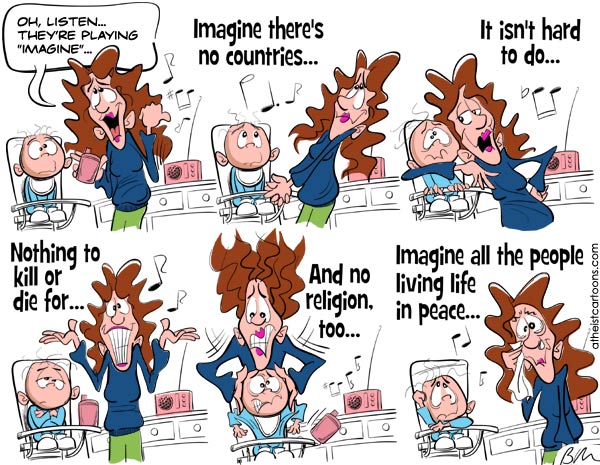Activities meet the following objectives:
- define atheism
- recognize that atheists have been the targets of discrimination
- read and discuss documents that protect the freedom of religious and nonreligious thought
- understand that respecting nonbelievers is as important as respecting people of different religious faiths
- learn about atheism and the rights of atheists
- teach others about what they have learned
- expand vocabulary by studying word roots
- What is atheism?
- What kinds of discrimination have atheists experienced?
- How can students promote respect for diverse religious believers and non- believers?
Vocabulary
atheist [ āthē ist ] (noun) someone who does not believe in God or a universal spirit
agnostic [ agˈnästik ] (noun) someone who says that knowledge of God’s existence is unknown or unknowable
secular humanist [ sekyələrˌ(h)yoōməˈnist ] (noun) someone who does not believe in God, but who has a belief system characterized by reason, ethics, and justice
deist [ dēˈist ] (noun) someone who believes that the world was created and set in motion by a supernatural agent which then does not take an active role or moral interest in humanity
free thinker [ frē ˈthing kər ] (noun) someone who believes in the right to freedom of thought, and strives to build opinions on the basis of facts and logical principles, while rejecting dogma, religion, scripture, tradition, or experience
Procedure
1. Choose a partner. Take turns reading aloud the facts on the Fact Sheet. With your partner, discuss how you feel about what members of this group have experienced. How do you think it might feel to belong to the group and not want others to know you are a member?
2. With your partner, formulate a response to what you have learned. Prepare your response as if you are talking to a member of the group. Tell that person what you have learned and how you feel about it. Tell him or her what you would like to do about what you have learned and why. Have pairs volunteer to present their responses to the class.
3. Before you find out what group you have been learning about, think about groups you know who experience discrimination because of who they are or what they think. Name the group and your teacher will put it on the chart. (Note: Fill these in on a chart that looks like the one on Groups Who Are Sometimes Treated Unfairly.)
4. Use the chart to think about patterns in the groups you listed. The chart includes some categories by which groups define themselves. For example, if you said that sometimes Muslims are treated unfairly, you can put a check in the column labeled “Religion,” because Muslims are a group defined by their religion. Read down your list and see what characteristics define the different groups you have identified.
5. Now watch this news report. It identifies the group you have learned about, and presents stories of people who have experienced the kind of discrimination you have just learned about. (Note: If you don’t have access to the report, students can read The Right of Unbelief —found at the bottom of the feature story "Belief in Action"—instead.) As a class, discuss: What is the definition of atheism? Are you surprised to find out the identity of the group? Why or why not? Have you heard about anti-atheist discrimination before?
6. Sometimes when people think about religious tolerance, they don’t think about respecting those who are not religious. How can you make others aware of being tolerant to nonreligious people? Working with your partner, create a tool that can educate others about the importance of respecting non-religious as well as religious diversity. Some of the things you can do:
- make a public service announcement
- create a Web site
- make a poster
- compile an annotated bibliography of Internet resources on the subject
- write a letter to students, parents, and local media outlets
7. Present your educational tool.
Extension Activity
Political Cartoon
Political cartoons present an opinion about a topic or a person in the news. To help you think about this cartoon, start by listening to the song “Imagine.” Then look at the images in this cartoon and read the words. How does the woman in the cartoon feel when she hears “Imagine” on the radio? How does she respond to the first three lines of the song? Then how does her response change when the subject is religion? Given what you’ve learned in this lesson, why do you think she responds differently? What comment is the cartoonist making?

Reprinted with permission. Teachers may purchase individual cartoons for other lesson plans at PoliticalCartoons.com.